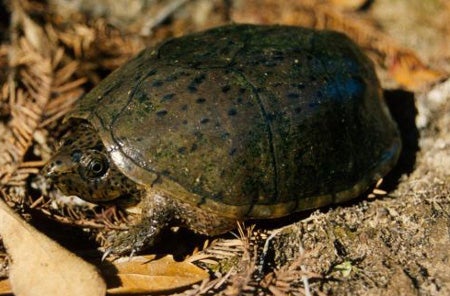SCIENTIFIC NAME:
Sternotherus minor
STATUS:
Loggerhead musk turtles, S. minor minor, common in southeastern Alabama from Tensaw River eastward to the Apalachicola River drainage of Barbour, Henry, and Houston counties. Subspecies S. minor peltifer, the striped-necked musk turtle, is common nearly statewide outside of S.m. minor range and Black Warrior River Basin. Low Conservation Concern.
DESCRIPTION:
The loggerhead musk turtle is a relatively small aquatic turtle, usually averaging 3 to 5 inches in length. It has a relatively large head which gives it the loggerhead name. The carapace (top part of the shell) is dark olive colored or brown. The carapace is slightly serrated and has a vertebral keel and lateral keels. The lateral keels may disappear with age. The shell has dark seams between the scutes and may be patterned with spots or streaks. The plastron (bottom part of the shell) is generally pink to yellow with a single gular scute. The head is light brown to grey with mostly round spots, splotches and sometimes yellow stripes. The snout is tubular with barbels present on the chin.
FEEDING HABITS:
The loggerhead musk turtle primarily eats insects and mollusks. It will also eat other turtles. Its large head and powerful jaws were developed to crack the shells of its prey, but it sometimes eats vegetation and decayed matter. It often crawls along the bottom of creeks and streams probing for food.
DISTRIBUTION:
Its range encompasses most of the southeastern United States from southern Virginia and eastern Tennessee down through Georgia, Florida and can be found in most of Alabama. It is not found in the Black Warrior drainage of central Alabama. Another musk turtle, the flattened musk turtle (Sternotherus depressus) occurs in the upper Black Warrior River drainage.
HABITAT:
Loggerhead musk turtles generally prefer slower moving rivers, creeks and streams with a soft bottom. It occurs mostly around snags and fallen trees in the shallow areas. It can also be found in ponds and lakes.
LIFE HISTORY AND ECOLOGY:
Loggerhead musk turtles rarely bask in the sun, but they may occasionally be seen in the leafy branches of trees protruding from the water. They are active both day and night, but most often may be seen in the morning. They can remain submerged for long periods of time and can actually obtain oxygen from the water through their skin. In the southern reaches of its range loggerhead musk turtles remain active year round. In cooler climates they must hibernate in soft bottoms of a waterway or in submerged rock crevices.
Loggerhead musk turtles rarely leave the water except to lay eggs. Males and females reach sexual maturity in approximately 4 and 8 years, respectively. They may have two to five clutches of between one and five eggs each. The females lay their eggs in shallow holes at the bases of trees or beside logs. It takes 61 to 119 days for the eggs to hatch depending on temperature. The hatchlings average about one inch in length.
Nests may be destroyed by a variety of small mammals, birds and other reptiles. The juveniles fall prey to a number of larger vertebrates, however the adults have few natural enemies. Alligators and humans are the primary predators for adults.
Habitat destruction, pollution and commercialization are the biggest threats to healthy populations. Pollution has a direct affect on its primary food source of mollusks and insects. Commercialization for the pet trade has increased demand on wild populations in recent years with loggerhead musk turtles selling for up to $35 each on the Internet.
REFERENCES:
Mirarchi, Ralph E., et al. , 2004. Alabama Wildlife Volume One, A Checklist of Selected Vertebrates and Invertebrates. The University of Alabama Press, Tuscaloosa, AL.
Ernst, Carl, et. al., 1994. Turtles of the United States and Canada. Smithsonian Institution Press, Washington, D.C.
Mount, Robert, 1975. The Reptiles and Amphibians of Alabama. The University of Alabama Press, Tuscaloosa, AL.
AUTHOR:
Michael Bloxom, Wildlife Biologist, Alabama Division of Wildlife and Freshwater Fisheries







